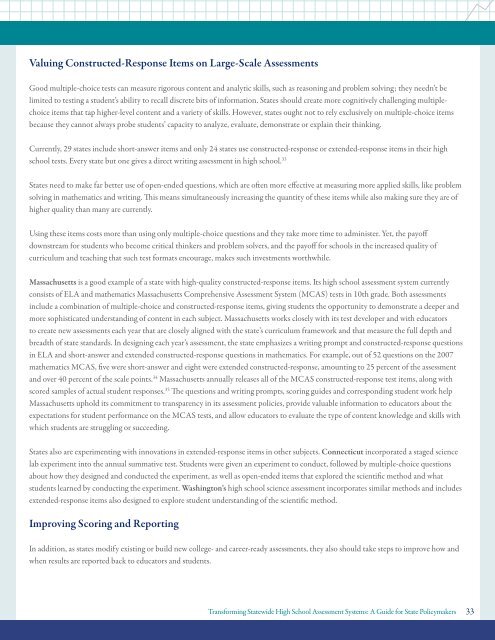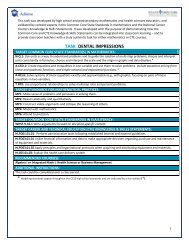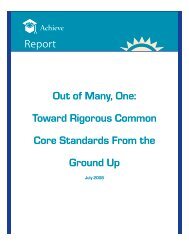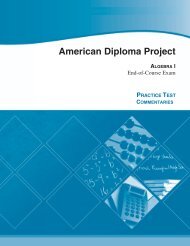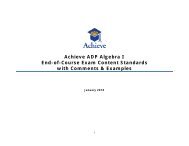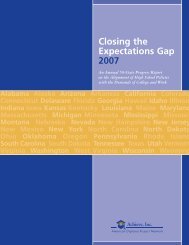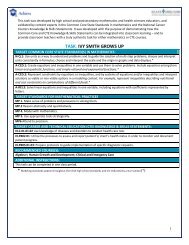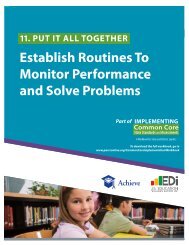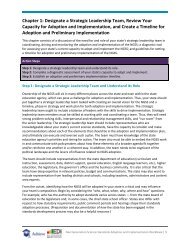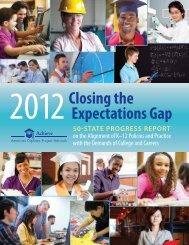Transforming Statewide High School Assessment Systems: - Achieve
Transforming Statewide High School Assessment Systems: - Achieve
Transforming Statewide High School Assessment Systems: - Achieve
Create successful ePaper yourself
Turn your PDF publications into a flip-book with our unique Google optimized e-Paper software.
Valuing Constructed-Response Items on Large-Scale <strong>Assessment</strong>sGood multiple-choice tests can measure rigorous content and analytic skills, such as reasoning and problem solving; they needn’t belimited to testing a student’s ability to recall discrete bits of information. States should create more cognitively challenging multiplechoiceitems that tap higher-level content and a variety of skills. However, states ought not to rely exclusively on multiple-choice itemsbecause they cannot always probe students’ capacity to analyze, evaluate, demonstrate or explain their thinking.Currently, 29 states include short-answer items and only 24 states use constructed-response or extended-response items in their highschool tests. Every state but one gives a direct writing assessment in high school. 33States need to make far better use of open-ended questions, which are often more effective at measuring more applied skills, like problemsolving in mathematics and writing. This means simultaneously increasing the quantity of these items while also making sure they are ofhigher quality than many are currently.Using these items costs more than using only multiple-choice questions and they take more time to administer. Yet, the payoffdownstream for students who become critical thinkers and problem solvers, and the payoff for schools in the increased quality ofcurriculum and teaching that such test formats encourage, makes such investments worthwhile.Massachusetts is a good example of a state with high-quality constructed-response items. Its high school assessment system currentlyconsists of ELA and mathematics Massachusetts Comprehensive <strong>Assessment</strong> System (MCAS) tests in 10th grade. Both assessmentsinclude a combination of multiple-choice and constructed-response items, giving students the opportunity to demonstrate a deeper andmore sophisticated understanding of content in each subject. Massachusetts works closely with its test developer and with educatorsto create new assessments each year that are closely aligned with the state’s curriculum framework and that measure the full depth andbreadth of state standards. In designing each year’s assessment, the state emphasizes a writing prompt and constructed-response questionsin ELA and short-answer and extended constructed-response questions in mathematics. For example, out of 52 questions on the 2007mathematics MCAS, five were short-answer and eight were extended constructed-response, amounting to 25 percent of the assessmentand over 40 percent of the scale points. 34 Massachusetts annually releases all of the MCAS constructed-response test items, along withscored samples of actual student responses. 35 The questions and writing prompts, scoring guides and corresponding student work helpMassachusetts uphold its commitment to transparency in its assessment policies, provide valuable information to educators about theexpectations for student performance on the MCAS tests, and allow educators to evaluate the type of content knowledge and skills withwhich students are struggling or succeeding.States also are experimenting with innovations in extended-response items in other subjects. Connecticut incorporated a staged sciencelab experiment into the annual summative test. Students were given an experiment to conduct, followed by multiple-choice questionsabout how they designed and conducted the experiment, as well as open-ended items that explored the scientific method and whatstudents learned by conducting the experiment. Washington’s high school science assessment incorporates similar methods and includesextended-response items also designed to explore student understanding of the scientific method.Improving Scoring and ReportingIn addition, as states modify existing or build new college- and career-ready assessments, they also should take steps to improve how andwhen results are reported back to educators and students.<strong>Transforming</strong> <strong>Statewide</strong> <strong>High</strong> <strong>School</strong> <strong>Assessment</strong> <strong>Systems</strong>: A Guide for State Policymakers 33


